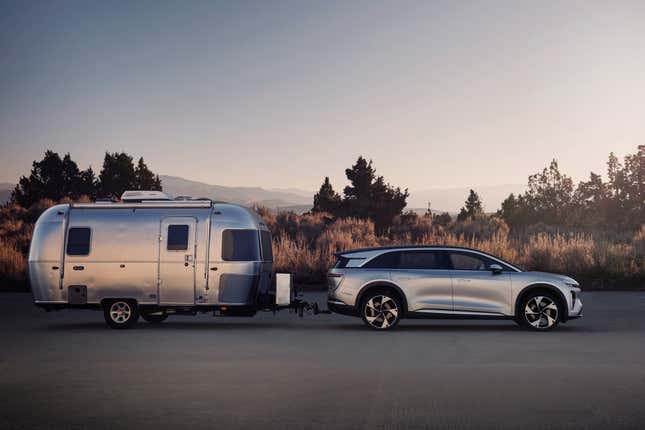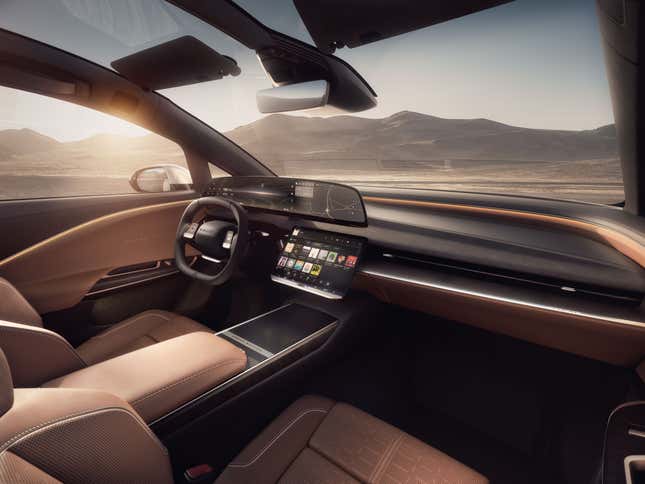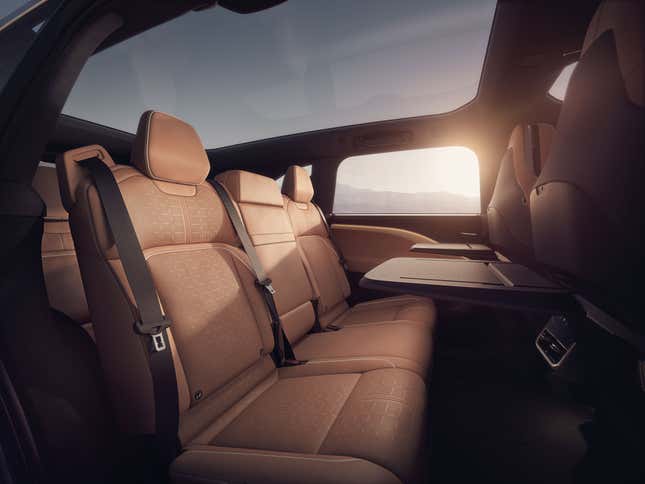Californian startup Lucid took a bold approach for its introduction to the world, launching in 2021 with the phenomenal Air, a large electric luxury sedan that entered a small, competitive segment of the auto market. Despite garnering tons of acclaim—including from me—the Air has been a slow seller and the brand has been losing a ton of money. Enter the new Lucid Gravity, a three-row SUV with super promising specs that will hopefully turn the company’s fortunes around.
Surprisingly, the Gravity rides on a totally new platform that was developed specifically for SUVs instead of just sharing the Air’s architecture. It also uses next-gen versions of Lucid’s motors, which are the most power dense production units in the world, and an updated 900-volt electrical architecture. In its top trim Lucid says the Gravity will hit 60 mph in under 3.5 seconds, have a payload capacity of more than 1,500 pounds and be able to tow at least 6,000 pounds. There’s an optional adaptive air suspension package that Lucid calls Zero Gravity, which will have manual height adjustments to assist with off-roading.
Lucid says the Gravity has a new battery pack that’s smaller, lighter and uses fewer precious materials, though no specs have been given. Using a 350-kW fast charger the Gravity will be able to gain 200 miles of range in just 15 minutes, and it should take less energy to charge than current Lucids.
As we’ve come to expect from Lucid, the standout figure is the Gravity’s range. Lucid is targeting a maximum range of over 440 miles for the Gravity’s top trim, which not only is far beyond any other electric SUV, but is greater than every other EV period save for the Lucid Air. That figure is even more impressive when compared to the longest range versions of other three-row SUVs—the Kia EV9 (304 miles), Mercedes-Benz EQS SUV (305 miles), Rivian R1S (352 miles) and Tesla Model X (348 miles)—and those ranges are mostly reserved for the lower-powered trims.
Helping achieve that massive range is a drag coefficient of just 0.24, which matches the Model X and bests every other three-row SUV (and most SUVs period). Unlike the Model X, though, the Gravity didn’t have to resort to a slippery coupe-like profile to achieve that figure, instead going for a traditional two-box silhouette. The Gravity is deceptively low and long, measuring 198.2 inches in length and 65.2 inches in height, making it an inch longer than a Kia EV9 and a smidge lower than a Mercedes-Benz R-Class. It’s got a stubby nose and short front overhang, a gently sloping low roofline that ends in a dramatic rear spoiler, and a generous rear overhang. Broad shoulders, big wheels that tapering roof give the Gravity a really hot stance, especially when viewed from the rear.

The design of the Gravity has evolved quite a bit from the initial concept that was teased in 2020, but it sticks closely to the design language established by the Air sedan. It’s got an aluminum blade up front that acts like a furrowed brow for the LED headlights just like on the Air, and the taillights are almost identical to the Air’s as well. The Gravity’s roof is finished in a contrasting aluminum finish, with some interesting trim at the floating D-pillar. The Gravity’s doors are frameless, and the side glass looks super flush.
Space is paramount to any three-row SUV, and the Gravity has it in spades. The second and third rows both fold flat to provide more than 112 cubic feet of cargo space, 30 cubic feet more than the EV9 and only 10 cubic feet shy of a Chevy Tahoe. If you don’t opt for the third row, the Gravity has 120 cubic feet of space. The Gravity also has a huge frunk that holds 8 cubic feet of stuff, with a large front opening and hinges that hold the hood at a near-90-degree angle so that people can sit and lounge in the frunk.

The second-row bench slides fore and aft for more legroom, and passengers in the middle seats can use tray tables that deploy from the front seatbacks. The Gravity’s panoramic sunroof stretches all the way back to the third row, and the windshield flows seamlessly into a pano roof panel as in the Air. (It doesn’t seem like the Air’s annoying sun visors have been redesigned, though.) All of Lucid’s images of the Gravity show a three-seat bench for the second row, but a pair of captain’s chairs will be optional down the line.
One of the biggest gripes with the Air has been Lucid’s infotainment system. While stunning to look at, it had lots of teething issues ranging from software bugs and missing features to just plain bad user functionality. Over-the-air updates have fixed a lot of the problems, but it’s still not perfect. The Gravity introduces Lucid’s next-generation user interface and control setup, and it looks to be much improved.

A curved 34-inch display sits atop the dashboard, and it appears as one seamless screen instead of three units put together like in the Air. The left half of the screen sits in front of the driver and acts as the gauge cluster, while the right half is touch-operated and is used for navigation, media or Apple CarPlay. Left of the gauges are touch controls for commonly used functions like the lights, defroster and tailgate, and the Gravity has a physical stalk for the wipers and turn signals. The steering wheel is a new squircle shape, and it has new touchpads to control the infotainment and cruise control that look much nicer than the Air’s annoying switches.
One of the Air’s coolest features is the Pilot Panel, a separate vertically oriented touchscreen in the center console that can be hidden away in the dash at the touch of a button. Sadly the Gravity’s Pilot Panel doesn’t seem to hide away, but it’s much larger and shaped like a tablet, and the menus have been redesigned to be much easier to use at a glance. There’s a new control bar at the bottom of the screen to easily access different settings, and the base of the screen has physical switches for the climate controls and volume.

Beyond the technology, the Gravity’s interior has a lot of cool design touches. There’s real wood and aluminum trim, and Lucid mixes fancy leather with sustainable materials like alpaca wool. Sadly, it doesn’t seem like the Gravity will have split color schemes for the interior like the Air, but lots of color is used throughout and the seats have cool stitching and perforation patterns. The center console has a glass cover that slides open to reveal the cupholders and storage cubbies, and Lucid’s cute bear logo is used in a few places.
Production of the Gravity will begin in late 2024 at the same Arizona factory that currently builds the Air. Lucid says the Gravity will start at under $80,000 for the base model, aligning it with the Air, though the top-end Dream Edition will likely come in around $150,000. We’ve got our boots on the ground at the LA auto show where the Gravity is making its public debut, so we’ll hopefully learn more details soon. Fingers crossed there will be a high-performance Sapphire model, too.

